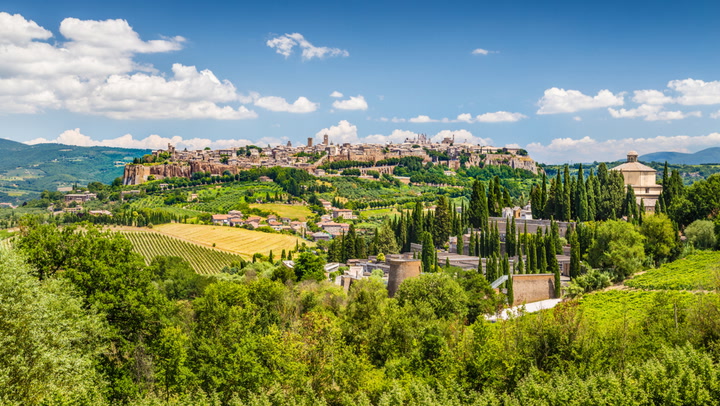Where to Eat, Drink, and Shop in Italy’s Charming Hill Town of Orvieto
Along the busy Autostrada A1, about halfway between Rome and Florence, Orvieto rises like a dreamy apparition—one of those places in Italy you’ve read about or seen in photos, but whose splendor can only be confirmed in person.
Located in west-central Umbria, Orvieto sits—looms, really—on a plateau of volcanic tufa that overlooks the valley formed by the winding Paglia River. Its sheer rock cliffs provided a natural means of defense for the Etruscans—among the pre-Roman tribes who controlled central Italy into the fourth century B.C.E. They lived on “the rock,” as Orvieto is known to locals, for centuries before finally capitulating to the Romans, who razed the city.
Orvieto lay abandoned until the Middle Ages when it became a Catholic stronghold and frequent hideout for popes during periods of plague, pestilence, and sackings in Rome. Its magnificent cathedral, or duomo, took 300 years to build and is one of Europe’s greatest examples of Romanesque Gothic architecture. The old city, or centro storico, is only a mile long from end to end, covered with an enthralling grid of narrow streets and alleys named after noble families of the medieval era. Hotels occupy grand old palaces, or palazzi, while restaurants, wine bars, and shops are tucked into centuries-old houses and storefronts.

Under street level, Orvieto becomes even more enigmatic. The city is built over a vast honeycomb of caves, tunnels, and cellars, some of which date to Etruscan times. This area was once used for cold storage or as hideouts and escape hatches from the city when it was under siege. Consequently, they’ve turned up a wealth of archaeological artifacts and information about medieval life. Some of these sites are now open for tours, and a trip into Orvieto’s underground world should be part of any visit here.
Must-Visit Attractions in Orvieto
There is a long list of must-visit attractions in Orvieto, including the aforementioned duomo and underground attractions, as well as art and archaeological museums and Etruscan and medieval archaeological sites. Here are just a few favorites, run by locals who were born and raised on “the rock.”

Marco Sciarra and his family operate Pozzo della Cava, a tourist attraction featuring an extensive series of underground caves, former pottery kilns, and a 36-meter (118 feet) well, or pozzo, from the 1500s. This well, built into a smaller Etruscan well from the sixth century B.C.E., once provided water for the city during sieges. The family also runs a bar and trattoria, gift shop, and ceramics studio.
When asked what enchants visitors about Orvieto, Sciarra refers to the city’s captivating history but also something more. “Orvieto has a mythic sense about it, that’s in a way bigger than the city itself,” he explains. “It once played such an important role in the history of Rome, of Europe, of Italy, of the church, and that history is evident everywhere.” However, the real magic, says Sciarra, is that Orvieto, despite its storied past, remains a vibrant, lived-in city. Consequently, visitors can easily experience that essence.
“If you spend a few nights up on the rupe (or the cliff, as Orvieto is also called), you can buy groceries at a little store where locals shop, participate in a neighborhood festival, or take a walk in the evening as residents are out strolling or walking their dogs,” Sciarra shares. That, for him, is what makes Orvieto unique, both for residents and visitors alike.

This “lived-in” quality, according to Cristian Manca, differentiates Orvieto from other more touristy destinations in neighboring Tuscany. Manca and his wife, Luana, run two family restaurants—longstanding Trattoria del Moro and the more casual Gastronomia Aronne, which features a deli counter. Both eateries create an informal atmosphere, making guests feel as though they are dining in the home of friends. “Even if visitors don’t speak the same language, our relaxed atmosphere, home cooking, and sense of place aim to make them feel welcome,” he notes.
This same hominess permeates Orvieto, which tourists take note of. “There are not many places left in Italy where you can eat in a restaurant while the owner’s kids (and maybe your own) play soccer in the street outside, or where anziani (old folks) still walk about with their canes. In a big city, you live and die, and no one notices.” However, that’s not the case in Orvieto; “We are a tourist center, but we’re essentially a village,” Manca adds.
A few blocks from Manca’s restaurants, Lamberto Bernardini concocts another type of recipe—a cure-all elixir once widespread in medieval Europe. Through tireless research in archives across the continent, Bernardini has resurrected the ancient formula and now sells it as an amaro, or digestif, from his shop, L’Orvietan, which is nearly in the shadow of the majestic duomo.
Bernardini emphasizes that the city’s history is practically woven into the DNA of Orvietani. “To live in the city where you were born and choose to remain, it’s just instinctual,” he says. He believes that Orvieto’s “geological and cultural stratification” grants him a sense of comfort, which he hopes visitors can also absorb. “We’re high on a rock, like a protected island. The palaces, the churches, the caves…there’s a history here that we are all part of, and that provides a feeling of security.”
For Orvieto tourist information in English, check the OrvietoViva website.





